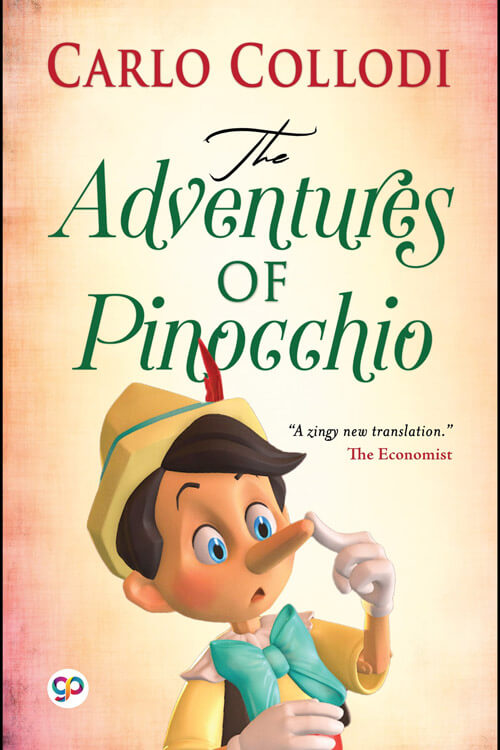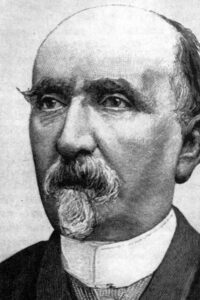
Adventures of Pinocchio
As soon as he gets home, Geppetto fashions the Marionette and calls it Pinocchio. This is one of Marionette’s first pranks.
Little as Geppetto’s house was, it was neat and comfortable. It was a small room on the ground floor with a tiny window under the stairway. The furniture could not have been more straightforward: an ancient chair, a rickety old bed, and a tumble-down table. A fireplace full of burning logs was painted on the wall opposite the door. Over the fire, there was painted a pot full of something that kept boiling happily away and sending up clouds of what looked like natural steam.
As soon as he reached home, Geppetto took his tools and began to cut and shape the wood into a Marionette.
“What shall I call him?” he said to himself. “I think I’ll call him PINOCCHIO. This name will make his fortune. I knew a whole family of Pinocchio once—Pinocchio, the father; Pinocchia, the mother; and Pinocchi, the children—and they were all lucky. The richest of them begged for his living.”
After choosing the name for his Marionette, Geppetto set himself to work to make the hair, the forehead, and the eyes. Fancy his surprise when he noticed that these eyes moved and then stared fixedly at him. Geppetto, seeing this, felt insulted and said in a grieved tone:
“Ugly wooden eyes, why do you stare so?”
There was no answer.
After the eyes, Geppetto made the nose, which began to stretch as soon as it was finished. It stretched and stretched and stretched until it became so long that it seemed endless.
Read or download Book
Carlo Collodi
Carlo Lorenzini (24 November 1826 – 26 October 1890), better known by the pen name Carlo Collodi, was an Italian author, humourist, and journalist. He is widely known for his fairy tale novel The Adventures of Pinocchio.
Early life
Collodi was born in Florence on 24 November 1826. His mother, Angiolina Orzali Lorenzini, was a seamstress from Collodi, the town from which he later took the pen name, and his father, Domenico Lorenzini, was a cook. Both parents worked for the marchese Ginori Lisci. Carlo was the eldest child in the family, and he had ten siblings; seven died at a young age. He spent most of his childhood in Collodi, where his mother was born. He lived there with his maternal grandmother. After attending primary school, he was sent to study at a theological seminary in Colle Val d’Elsa. An account at the seminary shows that the marchese had offered financial aid, but the boy did not want to be a priest, so he continued his education at the College of the Scolopi Fathers in Florence. In 1844, he started working at the Florentine bookstore Libreria Piatti, assisting Giuseppe Aiazzi, a prominent Italian manuscript specialist.
Career
During the Italian Wars of Independence in 1848 and 1860, Collodi volunteered with the Tuscan army. His active interest in political matters can be seen in his earliest literary works and in the founding of the satirical newspaper Il Lampione in 1853. This newspaper was censored by order of the Grand Duke of Tuscany. In 1854, he published his second newspaper, Lo Scaramuccia (“The Controversy”). Lorenzini’s first publications were in his periodicals. A debut came in 1856 with the play Gli amici di casa and parodic guidebook Un romanzo in Vapore 1856. By 1860, he published his first notable work called Il signor Alberi ha ragione! (Mr. Alberi Is Right!), which outlined his political and cultural vision of Italy. This is the text where Lorenzini started using the Collodi pseudonym taken from his mother’s hometown.
Collodi had also begun intense activity on other political newspapers such as Il Fanfulla; simultaneously, he was employed by the Censorship Commission for the Theatre. During this period, he composed various satirical sketches and stories (sometimes simply by collating earlier articles), including Macchiette (1880), Occhi e nasi (1881), and Storie allegre (1887).
Collodi became disenchanted with Italian politics afterwards, so he turned to children’s literature, and his first works involved translating French fairy tales into Italian. In 1875, for instance, he completed Racconti delle Fate, a translation of French fairy tales by Charles Perrault. In 1876, Collodi wrote Giannettino (inspired by Alessandro Luigi Parravicini’s Giannetto), the Minuzzolo, and Il viaggio per l’Italia di Giannettino. This educational series explored the unification of Italy through the ironic thoughts and actions of the character Giannettino.
Lorenzini became fascinated by the idea of using an amiable, rascal character to express his convictions through allegory. In 1880, he began writing Storia di un burattino (Story of a Marionette), also called Le avventure di Pinocchio, published weekly in Giornale per i bambini. Pinocchio was adapted into a 1940 Disney film that is considered one of Disney’s greatest films.
Collodi died suddenly in Florence on 26 October 1890 at the age of 63 and is interred at Cimitero Monumentale Delle Porte Sante. The National Carlo Collodi Foundation was established in 1962 to promote education and the works of Collodi, and Pinocchio Park opened in 1956 in the town of Collodi and remains a popular attraction today.






